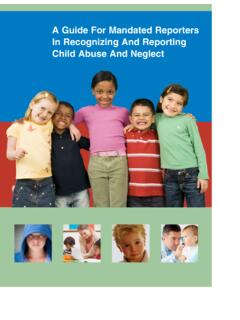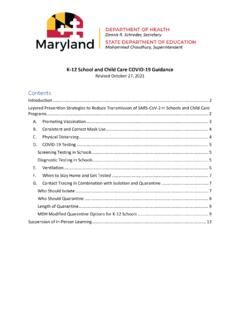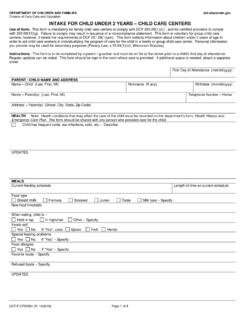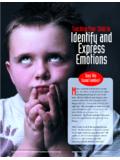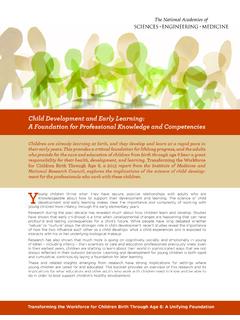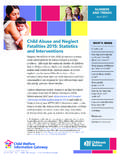Transcription of Child Safe Organisations: Example Code of Conduct
1 The National Principles for Child Safe Organisations outline the importance of organisations having effective policies and procedures that document how the organisation is safe for children and young people. The National Principles also emphasise the importance of embedding Child safety and wellbeing in organisational leadership, governance and culture. Developing and implementing a Child Safe Code of Conduct is one key aspect of fulfilling these principles. What is a Child Safe Code of Conduct ?A Child Safe Code of Conduct is a document outlining expected behaviours from all members of an organisation, and behaviours that are unacceptable, when interacting with children and young organisation s Child Safe Code of Conduct should: Identify to leaders, staff and volunteers the expected behavioural standards for engaging with children and young people in the organisation.
2 It should set a high standard of Conduct for the protection and wellbeing of children and young people. Cover Conduct in both the physical and online environments. Be easy for people to access and understand. Be covered in induction training for all staff and volunteers. Link to relevant legislation, the organisation s Child Safety and Wellbeing Policy and related policies and procedures, including those for receiving and responding to complaints and concerns and for reporting to external authorities. Link to relevant human resources and procurement processes in the organisation, for Example recruitment processes, individual contracts or terms of employment, and contracting of services from third Child Safe Code of Conduct This Example Child Safe Code of Conduct is designed to assist organisations to develop their own code. It provides general guidance on what might be included in a Child Safe Code of Conduct .
3 It should be adapted to suit the particular context in each organisation, including the ways in which people in the organisation engage with children and young people. It may also need to reflect regulatory requirements applicable to particular types of organisations or in particular states or Example is generally applicable to paid and unpaid staff in an organisation. Some aspects of a Code of Conduct might need to be adapted for application to different types of people involved in an organisation for Example , board members or executive leadership, third party consultants and contractors, or families and children who engage with the Code of ConductChild Safe Organisations: All paid and unpaid staff, including volunteers, interns or trainees of [the organisation] are responsible for the safety and wellbeing of children and young people who engage with [the organisation].
4 All paid and unpaid staff are expected to act in accordance with this Code of Conduct in their physical and online interactions with children and young people under the age of 18 will: Act in accordance with [the organisation s] Child safety and wellbeing policies and procedures at all times. Behave respectfully, courteously and ethically towards children and their families and towards other staff. Listen and respond to the views and concerns of children, particularly if they communicate (verbally or non-verbally) that they do not feel safe or well. Promote the human rights, safety and wellbeing of all children in [the organisation]. Demonstrate appropriate personal and professional boundaries. Consider and respect the diverse backgrounds and needs of children. Create an environment that promotes and enables children s participation and is welcoming, culturally safe and inclusive for all children and their families.
5 Involve children in making decisions about activities, policies and processes that concern them wherever possible. Contribute, where appropriate, to [the organisation s] policies, discussions, learning and reviews about Child safety and wellbeing. Identify and mitigate risks to children s safety and wellbeing as required by [the organisation s] risk assessment and management policy or process. Respond to any concerns or complaints of Child harm or abuse promptly and in line with [the organisation s] policy and procedure for receiving and responding to complaints. Report all suspected or disclosed Child harm or abuse as required by [relevant legislation] and by [the organisation s] policy and procedure on internal and external reporting. Comply with [the organisation s] protocols on communicating with children. Comply with [relevant legislation] and [the organisation s] policies and procedures on record keeping and information Safe Organisations: Example Code of Conduct Page 2 I will NOT: Engage in any unlawful activity with or in relation to a Child .
6 Engage in any activity that is likely to physically, sexually or emotionally harm a Child . Unlawfully discriminate against any Child or their family members. Be alone with a Child unnecessarily. Arrange personal contact, including online contact, with children I am working with for a purpose unrelated to [the organisation s] activities. Disclose personal or sensitive information about a Child , including images of a Child , unless the Child and their parent or legal guardian consent or unless I am required to do so by [the organisation s] policy and procedure on reporting. Use inappropriate language in the presence of children, or show or provide children with access to inappropriate images or material. Work with children while under the influence of alcohol or prohibited drugs. Ignore or disregard any suspected or disclosed Child harm or I think this Code of Conduct has been breached by another person in [the organisation] I will: Act to prioritise the best interests of children.
7 Take actions promptly to ensure that children are safe. Promptly report any concerns to my manager, [the organisation s] Child Safety Officer, the Chief Executive Officer or another manager or leader in [the organisation]. Follow [the organisation s] policies and procedures for receiving and responding to complaints and concerns. Comply with [legislative requirements on reporting] if relevant, and with [the organisation s] policy and procedure on internal and external agree to abide by this Code of Conduct during my employment with [the organisation]. I understand that breaches of this Code of Conduct may lead to disciplinary action or termination of my employment with [the organisation].. Full DateChild Safe Organisations: Example Code of Conduct Page 3


